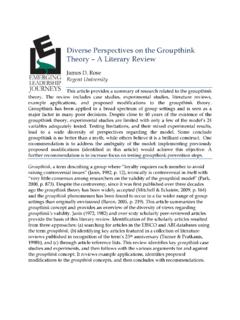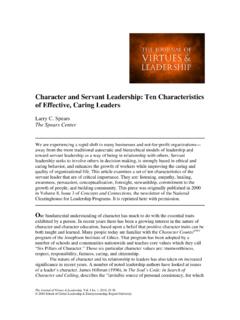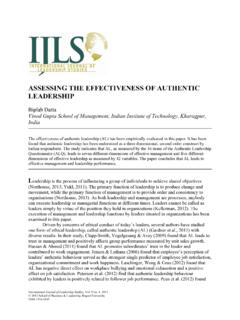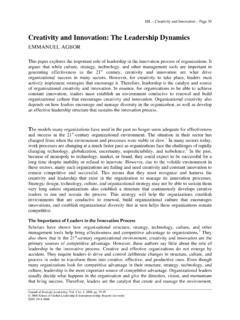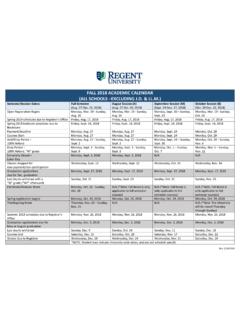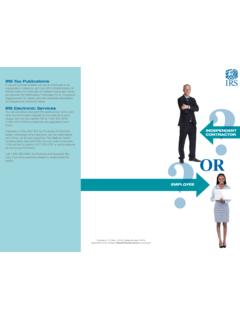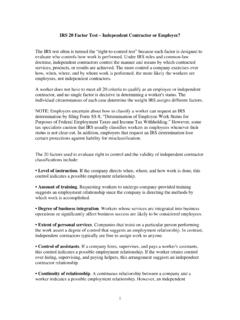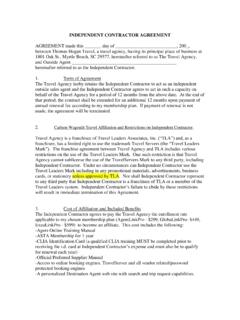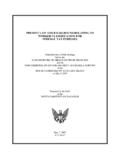Transcription of INDEPENDENT CONTRACTORS IRS 20-FACTOR TEST
1 INDEPENDENT CONTRACTORSIRS 20-FACTOR TESTAn INDEPENDENT contractor is a worker who individually contracts with an employer to providespecialized or requested services on an as-needed or project basis. This individual is free fromcontrol and direction of the performance of their work, and the individual is customarily engagedin an INDEPENDENT trade, occupation, profession, or CONTRACTORS have greater control over the way they carry out their work thanemployees. Employers assume fewer duties with respect to INDEPENDENT CONTRACTORS CONTRACTORS are generally outside the coverage of various laws that apply to theemployer-employee relationship.
2 An employer must exercise extreme caution when classifyinga worker as an INDEPENDENT contractor . This is especially important when it comes to issues suchas pension, workers compensation, and wage and hour law. Employers do not withhold federal,state and local taxes from wages paid to INDEPENDENT CONTRACTORS , they are not included in anemployer s benefits programs, are exempt from wage and hour, employment discrimination lawsand unemployment insurance. Therefore, the penalties for misclassifying a worker can be can include back taxes or premiums, civil fines, interest, and other retroactive INDEPENDENT contractor relationship is beneficial to both parties, so pursuing an independentcontractor arrangement is a practical way to do business for employers.
3 The IRS has developedguidelines to help the employer to correctly classify their employment relationships. The IRSfollows the common law test for determining whether an individual is an employee for federalemployment tax purposes. Under the common law test an employer-employee relationshipexists if the person for whom services are performed has the right to control and direct a workerin results, specific details and the means by which the results are Reasonable Basis test provides a safe harbor to employers, which bars the IRS fromchallenging the status of workers as INDEPENDENT CONTRACTORS if certain conditions are met.
4 If thefollowing conditions are met the employer does not have tax liability for workers under Section503 and the IRS cannot penalize an employer for misclassifying a worker as an independentcontractor: The employer has always treated the worker as an INDEPENDENT contractor The employer has filed all returns for the worker for all periods after 1978 and thereturns were consistent with INDEPENDENT contractor status The employer had a reasonable basis for treating workers as an independentcontractor by either relying on judicial precedent, published rulings or technicaladvice, a prior IRS audit showing no penalties assessed for similarly situated workers.
5 Or a longstanding recognized practice of a significant segment of the industry inwhich the individual IRS developed the 20-FACTOR Test shown below to help employers evaluate whether aworker is an employee or an INDEPENDENT contractor . No one factor on the test is more indicativeof employee status than another. If there is a high number of yes marks, then it will mostlikely indicate the presence of an employment relationship, a high number of no marks may ormay not indicate a contractor relationship. Therefore, it is best for employers to err on the sideof caution and to pursue an IRS ruling when in doubt. The important thing to remember whenevaluating the status is who has the right to control the work as to when and how it is and workers should file Form SS-8 (Determination of Employee Work Status forPurposes of Federal Employment Taxes and Income Tax Withholding) to get a determinationfrom the IRS as to whether or not a worker is an INDEPENDENT IRS has released a 123-page manual designed to provide guidance to employers.
6 Themanual simplifies and explains the 20-point test. For a copy of the manual, you can contact theIRS center nearest 20-FACTOR TEST CHECK YES OR NO1. InstructionsIs the worker required to comply withemployer s instructions about when,where, and how to work? YES NO2. TrainingIs training required? Does the workerreceive training from or at the direction ofthe employer, includes attending meetingsand working with experienced employees? YES NO3. IntegrationAre the worker s services integrated withactivities of the company? Does thesuccess of the employer s businesssignificantly depend upon the performanceof services that the worker provides?
7 YES NO4. Services Rendered PersonallyIs the worker required to perform the workpersonally? YES NO5. Authority to hire, supervise and pay assistantsDoes the worker have the ability to hire,supervise and pay assistants for theemployer? YES NO6. Continuing RelationshipDoes the worker have a continuingrelationship with the employer? YES NO7. Set Hours of WorkIs the worker required to follow set hoursof work? YES NO8. Full-time Work RequiredDoes the worker work full-time for theemployer? YES NO9. Place of WorkDoes the worker perform work on theemployer s premises and use thecompany s office equipment?
8 YES NO10. Sequence of WorkDoes the worker perform work in asequence set by the employer? Does theworker follow a set schedule? YES NO11. Reporting ObligationsDoes the worker submit regular written ororal reports to the employer? YES NO12. Method of PaymentHow does the worker receive payments?Are there payments of regular amounts atset intervals? YES NO13. Payment of Business and TravelExpensesDoes the worker receive payment forbusiness and travel expenses? YES NO14. Furnishing of tools and materialsDoes the worker rely on the employer fortools and materials? YES NO15. InvestmentHas the worker made an investment in thefacilities or equipment used to performservices?
9 YES NO16. Risk of LossIs the payment made to the worker on afixed basis regardless of profitability orloss? YES NO17. Working for more than one company ata timeDoes the worker only work for oneemployer at a time? YES NO18. Availability of services to the generalpublicAre the services offered to the employerunavailable to the general public? YES NO19. Right to dischargeCan the worker be fired by the employer? YES NO20. Right to quitCan the worker quit work at any timewithout liability? YES NO

